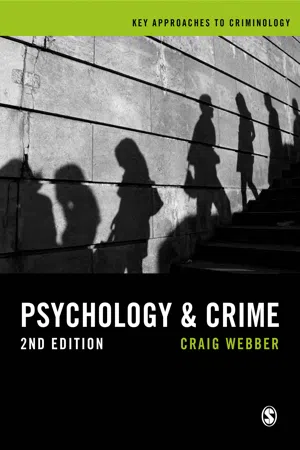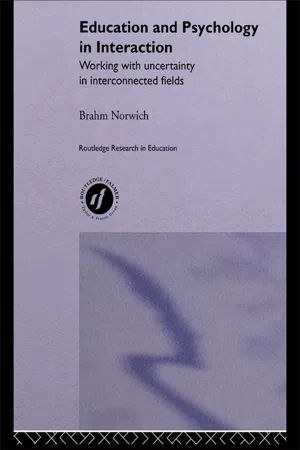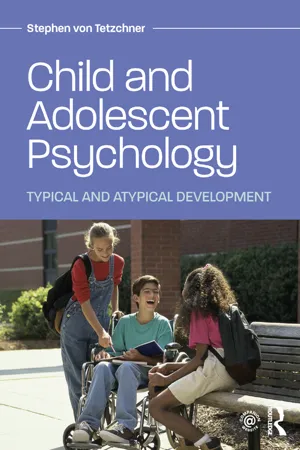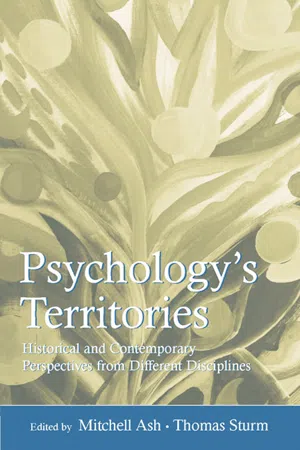Psychology
Psychological Perspectives
Psychological perspectives refer to the different approaches and theories used to understand and explain human behavior and mental processes. These perspectives include biological, cognitive, behavioral, psychodynamic, humanistic, and sociocultural viewpoints, each offering unique insights into the complexities of the human mind and behavior. By considering these diverse perspectives, psychologists can gain a more comprehensive understanding of human psychology.
Written by Perlego with AI-assistance
Related key terms
6 Key excerpts on "Psychological Perspectives"
- eBook - ePub
Early Childhood Studies
A Social Science Perspective
- Ewan Ingleby(Author)
- 2012(Publication Date)
- Bloomsbury Academic(Publisher)
The schools of psychologyOne answer to this question is that there is no definite answer. Philosophers have speculated for hundreds, perhaps thousands, of years about what has come to be known as ‘the mind-brain problem’. Whether you focus upon the mind or the brain depends upon your fundamental understanding of how psychology should be studied. Many Psychological Perspectives such as behaviourism, humanism, psychodynamic and cognitive theories emphasize the importance of the mind. This is because each of these perspectives has a clear understanding or model of the mind. In contrast biological perspectives are more likely to place an emphasis upon the genes and hormones influencing the brain.We can now look at exploring some of the Psychological Perspectives. This is a way of adding detail to our introductory explanations of what the subject area of psychology is. It is also a means of setting the scene before we look at how psychology can be applied to early years practice and Early Childhood Studies in particular.Table 1.1 gives a summary of five major schools of psychology together with a brief description of their key features.These schools of thought are especially useful to practitioners working with children and families because of the influence they have had in shaping the academic concerns of psychology. The practical application of this academic discipline appears to relate to much of the work that is undertaken with children and families. If you are working with children and families you will need to apply psychology through ‘modelling’ best practice and meeting the needs of children and families in an assertive manner. Knowledge and understanding of the competing perspectives in psychology can help you to achieve this ‘best practice’. The origins of the schools of thought go back to some of the earliest philosophical ideas to have influenced Western thought. The proposition that there are forces beyond the individual that shape social reality goes back to the ideas of the Greek philosopher Plato. This idea is central to behaviourism so the perspective has its intellectual origins in this classical thought. The notion that individuals interpret their social world as opposed to being ultimately shaped by this world goes back to the ideas of Aristotle (Audi, 1995). This philosophy is of central importance to humanism. In other words the genesis of the perspective’s dominant idea can be traced back to these early times. A summary of each of the key perspectives developing the definitions given in Table 1.1 - eBook - ePub
Psychology and Crime
A Transdisciplinary Perspective
- Craig Webber(Author)
- 2019(Publication Date)
- SAGE Publications Ltd(Publisher)
2 Psychological Perspectives on Crime Overview Moving on from a historical overview of social scientific understanding of crime, this chapter looks at the different Psychological Perspectives that constitute psychology. We will see that although they are sometimes presented as discrete areas of research, in fact there is some significant overlap between them. If we want to understand the problem of many accounts of crime, both sociological and psychological, then we can interrogate them through the lens of age. One of the key criminological truisms is that most people grow out of crime (Rutherford 1986/2002). This will be a recurring theme of this chapter so that the different Psychological Perspectives can be understood through issues like aging and desistance from crime. Key terms ■ Psychological Perspectives; Biological Psychology; Behaviourism; Cognitive Psychology; Psychoanalysis; Social Psychology The previous chapter explored the main approaches to understanding crime as they developed historically; this next chapter is a more in-depth overview of some of the major psychological approaches to studying human behaviour. This is not meant to be an exhaustive overview, merely a reminder for those who have already studied psychology, and an introduction for those who have not. All psychological approaches share the common focus of studying internal mental processes. Psychology can be distinguished from psychiatry through the latter’s focus on the study and treatment of mental illness and emotional disturbance. Psychiatry is a branch of medicine that, for the most part, focusses on illness and derivations from ‘normal’ 1 behaviour. Psychology is interested in a broader range of human behaviour that includes mental functions such as perception (e.g. taste, colour or object sizes), the capacity and ability of memory, as well as behaviour that some might describe as ‘abnormal’ such as aggression - eBook - ePub
Education and Psychology in Interaction
Working With Uncertainty in Interconnected Fields
- Brahm Norwich(Author)
- 2002(Publication Date)
- Routledge(Publisher)
There are different accounts of types of psychology. They vary depending on whether they come from textbooks, which tend to provide overviews for students on courses, or from proponents of particular strands or schools of thought. One view which was current in the middle of this century was that there were three broad positions: the behaviourist, the psychodynamic and the humanist. The behaviourist position represented the mechanistic scientific approach, which regulated its study by the disciplines of experimental and systematic empirical methodologies. The psychodynamic represented that family of approaches which assumed the central place of unconscious motivation and processes in human behaviour. The humanistic represented a family of approaches which assumed the active self-determining and interpretive nature of human behaviour. Over the last 20 years, since what has been called the ‘cognitive revolution’ (Bruner, 1997), information-processing assumptions have become dominant over classic behaviourist ones. However, some theorists would see a continuity between behavioural and cognitive principles and a unity in the adoption of experimental and empirical methodologies (Bandura, 1977).A key difference between the psychodynamic and humanistic traditions was in their attitude to conscious human agency. The original psychoanalytic theories associated with Freud recognised the determining role of instinctual and unconscious processes, whereas humanistic theories, such as those of Carl Rogers and George Kelly, stressed the active, conscious and reflective aspects of functioning. However, it is possible to see continuities between instinctually based psychodynamic and humanistic psychologies. This is evident in the reaction to Freudian ideas by post-Freudian theorists (e.g. Fromm, 1956) and more recent ego-oriented theorists (e.g. Kohut, 1978). It is also possible to see some versions of personal construct psychology integrated with analytic ideas and assumptions (Ryle, 1990). That there is no clear distinction between dynamic and humanistic psychologies can also be understood in terms of their shared origin in the practice of psychotherapy and counselling. What theoretical differences there are could be attributed to professional and institutional differences. Psychodynamic ideas of a psychoanalytic orientation were strongly regulated by the original psychoanalytic movement. Theorists who propounded variations were excluded, with the result that rival factions and traditions emerged. The original psychoanalytic ideas also derived from Europe and were more in tune with conservative values. Their adoption in the US increased stress on ego orientation and the emergence of humanistic traditions. The growth of counselling as a form of psychotherapy and as an alternative to the analytic version also led to the development of more humanistic theories. Counselling had a base which extended outside the treatment of people with serious mental health and illness problems. The emphasis was more on promoting personal development and well-being. - eBook - ePub
Child and Adolescent Psychology
Typical and Atypical Development
- Stephen von Tetzchner(Author)
- 2018(Publication Date)
- Routledge(Publisher)
2 THEORETICAL PERSPECTIVESThis chapter provides a brief introduction to the foundations of theory formation and the most important theoretical perspectives in developmental psychology: psychodynamic psychology, behaviorism, logical constructivism, social constructivism, evolutionary psychology, ethological psychology, ecological psychology, information processing and critical psychology. They differ in their emphasis and explanations of developmental phenomena and together they illustrate the breadth of developmental thinking in the twenty-first century. Each of them comprises many assumptions and hypotheses, and constitutes a basis for many smaller theories.The theories are presented in more detail in parts of the book where they are relevant, including critical comments. Chapter 10 , for example, discusses the cognitive aspects of the theories, while Chapter 18 discusses the development of personality.THE FUNCTION OF DEVELOPMENTAL THEORIES
Developmental theories are intellectual tools for categorizing and making sense of observations of children’s actions and reactions and their environment, and explaining typical and atypical developmental trajectories. As all tools, they must be functional and solid. A good theory requires a coherent set of interconnected concepts and a terminology that can be used to describe the development of the psychological phenomena and explain the relevant processes, for example concepts that can characterize children’s changing thinking or emotion understanding, and the processes that underlie these developmental changes (see Chapters 10 and 17 ). “The usefulness of theories may be evaluated in regard to its attributes of precision, scope and deployability” (Lerner, 2002, p. 11).According to Popper (1959), a theory has to be testable in order to be scientific. The first test of whether a theory is sound and tenable is to establish if it can account for and integrate existing research findings (Lerner, 2002). Popper also points out that theories cannot be proven - Dominic Upton(Author)
- 2013(Publication Date)
- Routledge(Publisher)
Differences between the dissatisfied CBT and PDT patients: Both patients experienced major problems in their relations to the therapists, but in different ways: CBT patients considered the therapist to be intrusive and oppressive; PDT patients felt the therapist was withdrawn, disengaged. The CBT patients were very disappointed and negative whereas the PDT patients were ambivalent.ImplicationsDissatisfied patients should be identified and asked about the reasons for their feeling and advised to try some other type of psychotherapy or another therapist who may better meet their needs and complaints.2.22 SummaryPsychological approaches to the person attempt to explain why people behave in a certain manner. Understanding the person requires an appreciation of a number of Psychological Perspectives. The psychodynamic approach explores how the unconscious mind is responsible for behaviour. Freud’s psychoanalytic approach suggests behaviour is a result of an interaction between innate drives and early experiences in childhood. According to Freud, the mind has three levels: the conscious, pre-conscious and unconscious. Freud also assumed that the mind could be divided into three basic sections the id (innate), ego (reality) and superego (morals). The ego protects itself by a number of defence mechanisms. Freud’s ideas have fallen out of favour or have been adapted to incorporate more social rather than sexual influences. A criticism of Freudian and other psychodynamic theories is that they do not translate into measurable observations and are therefore untestable. According to behaviourists, all behaviour is learnt from the environment (to the near exclusion of innate or inherited factors). Early behaviourist theories suggest that learning and behaviour are the result of conditioning (classical or operant). The focus of the behavioural approach is on the patient’s behavioural symptoms rather than on the underlying causes of the behaviour itself. - eBook - ePub
Psychology's Territories
Historical and Contemporary Perspectives From Different Disciplines
- Mitchell Ash, Thomas Sturm(Authors)
- 2007(Publication Date)
- Psychology Press(Publisher)
By themselves such contextualizations have, and must have, the effect of questioning, even dissolving long-held distinctions between “internal” and “external” histories of scientific disciplines, including psychology. Whether that dissolution is actually accepted by nonhis-torian members of a given discipline is another matter entirely. Among psychologists, in so far as they take any interest in history at all, it seems that “internal” history—meaning the stories psychologists tell one another about the development of their discipline—is still very much alive. This is particularly true of the many textbooks on history and systems of psychology produced for required courses in the subject, but not only there. Such histories often edit out precisely the con textual dimensions that historians of science and general historians find most relevant. In addition, they either ignore or construct barriers against the stories other nonpsychologists tell about the subject matter of the discipline.Quite similar tensions appear when psychologists and philosophers, or psychologists and neuroscientists attempt to discuss what may appear at first to be similar topics. There have been countless disputes about the nature and workings of the mind, or the relations of mental processes to the operations of the brain. And often enough it seems as though what academic psychologists have discovered or find interesting bears little relation to what nonpsychologists want to know or discover about themselves. A common and understandable, but entirely unhelpful and scientifically unproductive response is to circle the wagons and stick to the tried and true, either paying no attention to what outsiders may say, or declaring such viewpoints uninteresting or even unscientific.While introducing the approaches taken in the contributions to this volume, I would like to present a thematically oriented approach combining historiography of psychology in its present form with certain broader considerations from the history of science and general history (see also Ash, 1992). My belief is that such an approach will contribute to clarifying the social and cultural situation of contemporary psycho logical and social science research. In the case of psychology, this approach seems particularly appropriate, in view of the number of disciplines employing psychological methods of various kinds as well as the wide variety of psychological doctrines and practices outside academic settings.FoundationsThe approach taken here is based on three propositions:1. The history of psychological thought cannot be reduced to that of the discipline called psychology, narrowly constructed
Learn about this page
Index pages curate the most relevant extracts from our library of academic textbooks. They’ve been created using an in-house natural language model (NLM), each adding context and meaning to key research topics.





